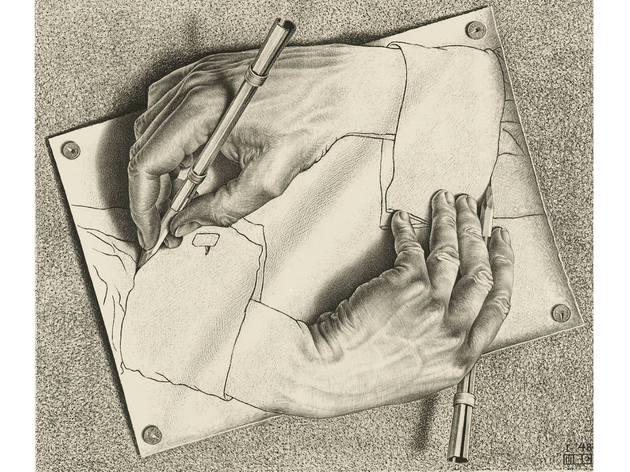
For this assignment, MC Esher was an artist that came to mind as a good choice. His works stick out in my mind, and probably for a reason that a lot of others can relate to – I was constantly seeing his works in my childhood spaces, such as doctors’ offices, my teachers’ classrooms, and various other locations.
This particular piece is called, “Drawing Hands,” from 1948 (mcesher.com). It is a lithograph that was completed in Holland (aaronartprints.com). I think that, in this work, the optical texture is a very important aspect. Because it is a drawing of human hands, evolving from two dimensional to three dimensional, it doesn’t seem as though the drawings feeling would be conveyed nearly as well if the texture didn’t also express the change from two dimensional to three dimensional.
For the same reason, the continuous lines seem equally as important. Without the seamlessly flowing line work, we would not be able to follow the graduation as smoothly. I believe that the lines also mirror the graduation in their strength – while they’re a bit more thin while the hands are two dimensional, the lines seem much more strong once it reaches the three dimensional area.
Escher’s ability to play with two and three dimensional parts in the same drawing also calls attention to his ability to force perspective in this image.
All in all, I think that this piece is meant to be a statement about the potential to create held within our hands, just as much as it is supposed to be a piece that forces you to really look at it and get your own perspective on where the beginning and ending really are.
Works Cited
“Drawing Hands.” Drawing Hands by Escher, http://www.aaronartprints.org/escher-drawinghands.php.
Pixelday. “M.C. Escher.” M.C. Escher – Drawing Hands, http://www.mcescher.com/gallery/back-in-holland/drawing-hands/.
Hi Linnea,
I really enjoy this piece of artwork and it’s originality. I like how you point out the transition from two dimensions to three dimensions. That definitely had me do a double take when I first glanced at the photo! I like how this photo is simple yet abstract in the way that it is very plain in color but very detailed. I think the precise detail of the fingers in this photo really bring the hands to life.
LikeLike
Hi Linnea, I actually found this piece of artwork very appealing, and I do have to admit, I think it really does show you what your hands could do. The potential of the creation of just your two hands. The photo is so simple, but means so much at the same time.
LikeLike
I really enjoy the cyclical nature of a lot of MC Esher’s works like what is displayed in this piece. It almost makes you feel a little lost following the painting around and around noticing things on each loop. You pointed out how the thickness of the lines change as the hand transitions from 2D to 3D. I thought that was pretty interesting and a good way to subtly differentiate between the two states.
LikeLike
Linnea,
I have always enjoyed MC Escher’s work, and this drawing is no exception. I think that the clean lines of this piece give it a very refined and polished look. The transition from simple two-dimensional sketch to complex, photorealistic three-dimensional hands could perhaps be an allegory for the progression of art from simple, haunting cave paintings to complex, intricate works, not just drawings, but sculpture too. And the cyclical nature of the piece is extremely interesting too. overall a very symbolic piece that has many layers and meanings to unravel.
I would have liked to see Escher try to paint more surreal landscapes and portraits, but then again I think that everything that he’s done is wonderful. I think you made a great choice and have a lot of great analysis here.
LikeLike